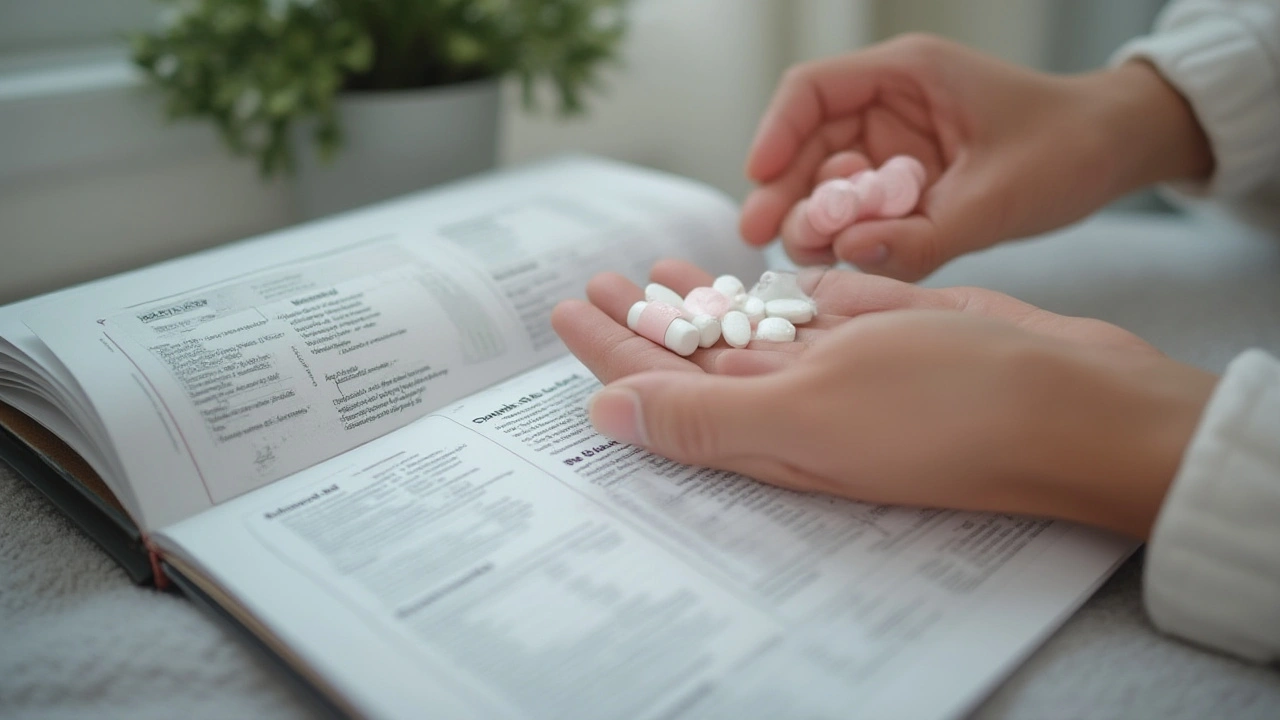Hands sweating, heart pounding, your world feeling as if it’s suddenly caving in. Panic attacks don’t exactly wait for when you’re ready. For a lot of people caught in that spiral, the medicine cabinet becomes the first place of hope—or sometimes, a gamble. Diphenhydramine and hydroxyzine are both old-school antihistamines, but neither started out as anxiety meds. Yet here we are: doctors prescribing hydroxyzine for acute anxiety, while others reach for diphenhydramine over the counter, hoping for some relief. So which one actually calms a panic attack faster and more reliably? Let’s tear into what really sets these two antihistamines apart when it comes to crushing that sudden wave of fear.
How Diphenhydramine and Hydroxyzine Tackle Panic: Chemistry, Brain Effects, and What Makes Them Different
People know diphenhydramine best as Benadryl, the pink little tablet you grab for allergies or sleepless nights. Hydroxyzine? That ends up in prescriptions as Atarax or Vistaril. Sure, both are antihistamines—blocking the H1 histamine receptor your body uses to freak out about pets, pollen, or bug bites. But the way they work on your brain (and nerves) is different enough to make a real difference for panic attacks.
Diphenhydramine slides across the blood-brain barrier easily, which is why it makes you sleepy. It acts on both histamine and acetylcholine receptors. This double-whammy is why you’ll feel knocked out or groggy, but also why some people try it for anxious feelings when they can’t get a prescription med quickly. Hydroxyzine, on the other hand, is less about sedation and more about calming. It’s approved by the FDA for anxiety—mainly because it doesn’t just block histamine, but also calms your brain’s serotonin activity a bit. That means its effect isn’t just about knocking you out, but about dialing down that spike in anxiety or panic.
There’s also the fun fact that hydroxyzine gets turned into cetirizine (Zyrtec) inside your body. That’s right—the allergy drug. But hydroxyzine’s journey through the liver first gives it those extra calming effects. Diphenhydramine just does its job as-is, which makes its action a little more blunt and less refined.
Let’s break this story down even more clearly:
| Medicine | Common Brands | FDA Approval for Anxiety? | OTC or Rx? | Common Side Effect |
|---|---|---|---|---|
| Diphenhydramine | Benadryl | No | Over the Counter | Drowsiness |
| Hydroxyzine | Atarax, Vistaril | Yes | Prescription | Dry Mouth |
Hydroxyzine gets the FDA approval badge for treating anxiety. Diphenhydramine? Not officially, though you’ll catch people mentioning it online and in forums for managing panic symptoms. So, there’s not just a chemical difference—there’s a legal difference, too.

Onset Time and Effectiveness: Which One Actually Works Faster When Panic Hits?
Moments matter when your heart is thumping in your chest and you just want something—anything—to make it stop. Let’s talk real-world numbers. Diphenhydramine, when swallowed, starts working in about 15-30 minutes. Hydroxyzine, taken by mouth, kicks in anywhere from 15-60 minutes, but most people report feeling calmer within 30-45 minutes. Both peak after about two hours, though the sedation from diphenhydramine can last much longer, sometimes leaving you with a “hangover” feeling into the next day.
Actual head-to-head studies on panic attacks are rare, but here’s what clinics and emergency rooms see: Hydroxyzine tends to calm patients more gently and without the heavy grogginess diphenhydramine brings. People who use Benadryl for panic sometimes say it “knocks them out” but doesn’t help as much with the racing thoughts—more like a sledgehammer than a scalpel. Hydroxyzine, even though it’s officially an anti-allergy drug, has shown repeatedly in published studies to help reduce symptoms in patients with generalized anxiety and panic, and most doctors write it as a short-term rescue med. If you have a prescription, it’s often considered a first-line, fast-acting option for acute panic when other anti-anxiety meds (like benzos) might be risky or habit-forming.
But here’s a twist: both drugs lose steam if you use them all the time for panic attacks. Tolerance to the sedating effect creeps up with repeated use—especially with diphenhydramine. That means if you rely on Benadryl several times a week, not only do you face brain fog and daytime sleepiness, but your body gets less responsive with time. Hydroxyzine seems to keep its calming punch a little longer, mostly because it doesn’t build tolerance as quickly. Still, both these meds are best for occasional, not daily, relief.
It’s worth asking: is it ever a good idea to grab diphenhydramine for a panic attack if you don’t have a hydroxyzine prescription? The answer’s not black and white. According to this detailed discussion about diphenhydramine for anxiety, people trying to self-medicate run into issues with side effects and risk missing out on better, safer alternatives. Plus, if you chase the “quick fix” more than once in a while, you could end up masking symptoms that should really be tackled with therapy or prescription meds designed for anxiety.

Prescription Access, Safety, and What To Watch Out For
You can walk into any pharmacy in the U.S. and buy diphenhydramine without a prescription. That easy access makes it tempting. But the safety story isn’t that straightforward. Diphenhydramine’s side effect list includes extreme drowsiness, dry mouth, blurred vision, and even confusion—especially in older adults. In large doses, it’s notorious for causing delirium or even hallucinations. Not pretty if you’re already anxious.
Hydroxyzine, because it’s prescription-only, involves a doctor or at least a telemedicine visit. That might sound like a hassle, but it’s actually part of what makes it safer for people with panic attacks. Your provider will check if you have heart rhythm issues, liver problems, or are taking meds that could interact. The anti-anxiety dose is well known—usually 25 to 50mg, taken up to three or four times a day, and always the lowest effective amount. Hydroxyzine’s milder side effects list often includes dry mouth, sometimes a little drowsiness, and headache. You don’t get the hard crash that Benadryl brings, so you’re much less likely to feel “hung over” the next morning.
- Tip: Never mix diphenhydramine or hydroxyzine with other sedatives or alcohol—this can slow down your breathing and amplify that groggy feeling, making things dangerous.
- Tip: If you take meds for depression, ADHD, or blood pressure, always run combinations by your doctor. Both antihistamines can interact with other medicines.
Want a fun number? In a 2023 report, ER visits for accidental overdoses with diphenhydramine outnumbered those for hydroxyzine 6 to 1. It’s easy to get carried away with Benadryl, not realizing bigger doses don’t always mean faster or better relief—they just mean more side effects. Doctors rarely see this with hydroxyzine because monitoring is built in from the start.
So, what’s the real take? With panic attacks, both these meds have a place—but it’s not a level playing field. Hydroxyzine is by far the safer and more effective choice if you need an as-needed pill to take the edge off anxiety. You do need a prescription, but most clinics (and now many telemedicine sites) prescribe it for acute panic, sometimes even as a “bridge” while you wait for long-term anxiety meds to kick in. Diphenhydramine? It’s there for emergencies or if you absolutely have nothing else, but it’s a blunt tool: quick, but not without plenty of baggage. And if you’re considering using either on a regular basis, the best outcome always involves talking with a real health professional, not just your local pharmacist.


13 Comments
Eric Pelletier
Hydroxyzine’s half-life is ~20 hours, so it’s not just a rescue med-it’s a sustained dampener on H1 and 5-HT2A receptors. Diphenhydramine? Shorter half-life (~4-10h), but it’s a potent muscarinic antagonist too, which explains the dry mouth, blurred vision, and cognitive fog. If you’re using this for panic, hydroxyzine’s pharmacokinetics are just… cleaner. No anticholinergic dumpster fire. Also, the FDA approval isn’t just bureaucracy-it’s clinical validation from RCTs with GAD and panic disorder cohorts.
Hadrian D'Souza
Oh wow, a *real* doctor wrote this? I’m shocked. 🤯
Let me guess-you also think aspirin cures existential dread and Prozac is just ‘fancy coffee.’ Hydroxyzine? Sure, it’s ‘FDA-approved for anxiety,’ but let’s be real: it’s just Benadryl with a PhD and a lab coat. People don’t need prescriptions to feel less like a terrified raccoon in a microwave. Benadryl’s been saving lives since 1946. The system wants you dependent on $80 scripts. I’ll take my $5 pink pill and my dignity, thanks.
Robert Spiece
It’s not about which drug works faster-it’s about what you’re trying to escape.
Benadryl doesn’t calm panic-it erases you. Hydroxyzine doesn’t fix anxiety-it just lets you sit with it without screaming. One’s a blackout. The other’s a breath.
But here’s the real question: why do we treat panic like a glitch in the system to be patched with chemicals? Why not ask why the system is glitching in the first place? The pill isn’t the solution-it’s the symptom of a culture that outsources inner turmoil to pharmacies.
And yet… I still keep hydroxyzine in my nightstand. Because philosophy doesn’t stop your heart from trying to climb out of your chest.
Vivian Quinones
I don’t care what the science says. Benadryl is AMERICAN. Hydroxyzine? Sounds like some fancy European medicine. We don’t need that stuff here. If you can’t handle a little drowsiness, maybe you shouldn’t be living in the real world. My uncle took Benadryl for 20 years and still drove his truck to work. That’s grit. That’s America.
Nonie Rebollido
Just took hydroxyzine for the first time last week. Felt like someone turned down the volume on my brain. Not sleepy. Not zoned out. Just… quiet. Like my thoughts finally stopped trying to punch me in the face. Benadryl? I tried it once. Felt like I was underwater in a dream. Didn’t help the panic. Just made me forget why I was scared. 🤷♀️
Marshall Pope
so like… i’ve been using benadryl for panic attacks since college. i know it’s not ideal. but it’s what i have. and it works… kinda. i just hope i’m not ruining my brain. anyone else feel like they’re one bad night away from becoming a zombie?
Eric Pelletier
Marshall-your concern is valid. Repeated diphenhydramine use increases dementia risk in older adults (per JAMA 2015). Even under 50, chronic use can impair memory consolidation and reduce hippocampal volume. Hydroxyzine? No such signal in the literature. It’s not about ‘being weak’-it’s about neuroprotection. You’re not a zombie. You’re just using a blunt instrument. There’s a scalpel available.
Abhay Chitnis
Bro… hydroxyzine is just Zyrtec’s older brother who went to med school 😂
Benadryl is the OG. The real MVP. If you need a script for anxiety, maybe you’re not trying hard enough to breathe. Also, India uses both but prefers Ayurveda. You guys in US think pills fix everything. LOL. 🤣
Rekha Tiwari
Hey! I’m from India too! 🙋♀️ I used to take Benadryl for panic too-felt like my brain was full of static. Then my therapist got me hydroxyzine. It didn’t make me sleepy, just… softer. Like my thoughts had a hug. I still take it sometimes, but now I also do box breathing. And I don’t feel guilty. 💛 You’re not broken. You’re just trying to survive. And you deserve gentler tools.
Agha Nugraha
Interesting breakdown. I’ve used both. Hydroxyzine felt more like a calm breeze. Benadryl felt like being hit with a pillowcase full of bricks. Also, the tolerance thing is real-I used to need 100mg of diphenhydramine to feel anything. Now I can’t even sleep with it. Hydroxyzine still works at 25mg after months. Not saying one’s better, just… more sustainable.
Leah Beazy
I used to think meds were for ‘other people.’ Then I had a panic attack in a grocery store. I bought Benadryl. Took it. Sat in my car for 45 minutes crying. Didn’t help. Then I got hydroxyzine from my doc. Took one. Sat in my car. Breathed. Felt… okay. Not fixed. But okay. That’s enough. You don’t need to be brave. You just need to be alive. 💪
Andy Smith
For the record: hydroxyzine’s anxiolytic efficacy is dose-dependent, with optimal results at 25–50 mg QID; its metabolite, cetirizine, lacks significant CNS penetration, which preserves its safety profile. Diphenhydramine’s anticholinergic burden elevates cardiac risk (QT prolongation), especially in polypharmacy patients. Moreover, while OTC accessibility fosters self-medication, it also correlates with increased ER visits due to intentional overdose (CDC, 2022). Evidence-based practice favors hydroxyzine for acute panic episodes-particularly in patients with comorbid insomnia or allergic rhinitis-due to its dual mechanism, lower abuse potential, and lack of anticholinergic toxicity. Always consult a provider before long-term use, regardless of route.
Brandon Benzi
You people are ridiculous. This whole post is just a Big Pharma ad. Hydroxyzine? It’s just another drug they want you hooked on. Benadryl’s been around since the 1940s. It’s not a ‘blunt tool’-it’s a tool. Simple. Effective. Real. You want to feel better? Stop looking for magic pills. Go outside. Walk. Breathe. Stop being so soft. The world doesn’t care if you panic. Neither should you.